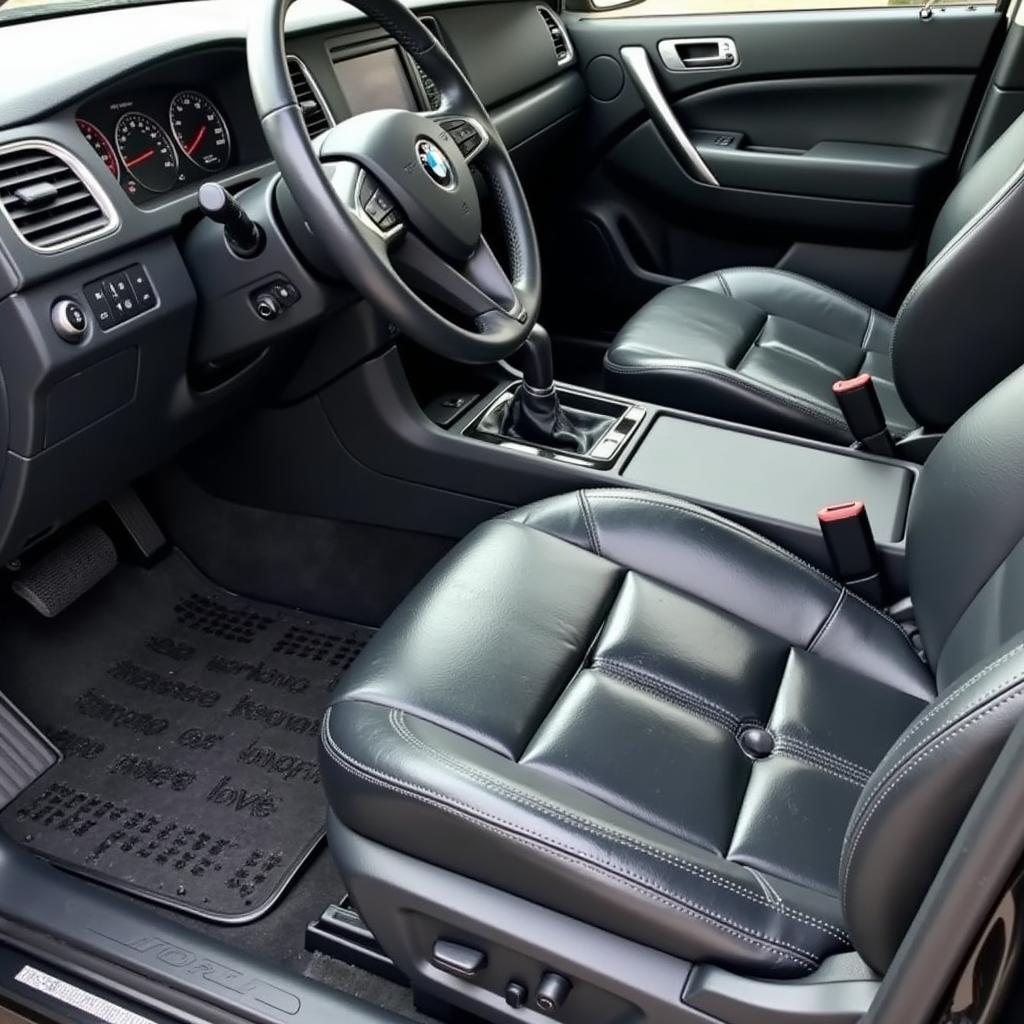After a thrilling off-road trip or a long road journey, your car deserves some serious TLC. Knowing how to detail your car after such adventures not only restores its showroom shine but also protects its value and extends its lifespan. Let’s dive into a comprehensive guide on how to bring your car back to its pristine condition.
Pre-Wash Preparation: The Foundation of a Great Detail
Before you even think about soap and water, a proper pre-wash is crucial. This stage removes loose dirt, grime, and bugs, preventing swirl marks during the main wash. Start by rinsing your car thoroughly with a pressure washer to remove the largest debris. Next, apply a quality bug and tar remover to dissolve stubborn insect remnants and road tar. Don’t forget to pre-treat heavily soiled areas like wheel wells and lower panels with a dedicated all-purpose cleaner. This step significantly reduces the risk of scratching your car’s paint during the wash process.
The Two-Bucket Wash Method: Protecting Your Car’s Finish
The two-bucket method is the gold standard for car washing, minimizing the chances of scratching your car’s paint. One bucket holds your soapy water, and the other contains clean rinse water. Dip your wash mitt into the soapy water, wash a section of the car, then rinse the mitt in the clean water before returning to the soapy water. This process ensures that you’re always washing with clean, grit-free water. Use a pH-neutral car wash soap specifically designed for automotive paint to avoid stripping away any protective wax or sealant.
Decontamination: Removing Stubborn Contaminants
Even after a thorough wash, microscopic contaminants like iron particles and tree sap can remain on your car’s paint. Decontamination involves using specialized products like iron removers and clay bars to safely lift these contaminants, leaving a perfectly smooth surface. Iron removers react with iron particles, turning them purple, visually demonstrating their effectiveness. Clay bars, used with a dedicated lubricant, gently glide across the paint, picking up any remaining embedded contaminants.
Polishing: Restoring Paint Perfection
After decontamination, you can address any imperfections like swirl marks, light scratches, and oxidation through polishing. This process involves using a polishing machine and specialized polishes to level out the paint’s surface and restore its clarity and shine. If you’re new to machine polishing, it’s best to start with a less aggressive polish and pad combination to avoid removing too much clear coat.
Protecting Your Investment: Applying Sealants and Waxes
Now that your car’s paint is pristine, it’s time to protect it. Sealants and waxes provide a barrier against environmental contaminants, UV rays, and water spots. Sealants generally offer longer-lasting protection, while waxes provide a deeper, warmer shine. Choose the product that best suits your needs and apply it evenly across the painted surfaces.
Interior Detailing: A Fresh and Clean Cabin
Don’t neglect the interior! Vacuum the carpets and upholstery thoroughly, paying attention to crevices and hard-to-reach areas. Use a dedicated interior cleaner to wipe down all surfaces, removing dust, dirt, and fingerprints. Condition leather seats to prevent cracking and fading. Don’t forget to clean the windows and mirrors for a streak-free finish.
Addressing Specific Interior Issues
For stubborn stains or odors, consider using specialized cleaning products. Enzyme cleaners are effective at breaking down organic stains and odors, while ozone generators can eliminate persistent smells.
“A well-detailed interior not only looks great but also contributes to a healthier and more enjoyable driving experience,” says renowned detailing expert, James Carter of Auto Detailing Pro.
 Clean and Detailed Car Interior
Clean and Detailed Car Interior
Final Touches: The Finishing Details
The final touches bring everything together. Dress the tires with a tire dressing to restore their deep black appearance. Clean and polish any chrome or metal trim. Finally, step back and admire your hard work.
Conclusion: Maintaining Your Car’s Beauty
Knowing how to detail your car after an adventure is a valuable skill. By following these steps, you can keep your car looking its best, protecting its value and extending its life. Regular detailing is an investment that pays off in the long run.
FAQ
- How often should I detail my car? This depends on your driving conditions and personal preference, but generally, every 3-6 months is a good guideline.
- Can I detail my car myself? Absolutely! With the right tools and techniques, anyone can achieve professional-looking results.
- What is the difference between a sealant and a wax? Sealants are typically synthetic and offer longer-lasting protection, while waxes are often natural and provide a warmer shine.
- How can I remove water spots? A dedicated water spot remover can be effective, but for stubborn spots, polishing may be necessary.
- What is the best way to clean leather seats? Use a dedicated leather cleaner and conditioner to clean and protect the leather.
- How do I prevent swirl marks? The two-bucket wash method and proper drying techniques are key to preventing swirl marks.
- What are the essential tools for car detailing? Essential tools include wash mitts, microfiber towels, buckets, a pressure washer, and various cleaning products.
“Remember, consistency is key in car detailing. Regular maintenance will keep your car looking its best and minimize the effort required for each detail,” adds Carter.
For further assistance, please contact us via WhatsApp: +1(641)206-8880, or Email: [email protected]. Our customer support team is available 24/7.

Leave a Reply